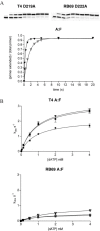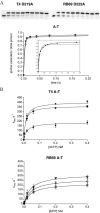Kinetics of error generation in homologous B-family DNA polymerases
- PMID: 16687658
- PMCID: PMC1459414
- DOI: 10.1093/nar/gkl300
Kinetics of error generation in homologous B-family DNA polymerases
Abstract
The kinetics of forming a proper Watson-Crick base pair as well incorporating bases opposite furan, an abasic site analog, have been well characterized for the B Family replicative DNA polymerase from bacteriophage T4. Structural studies of these reactions, however, have only been performed with the homologous enzyme from bacteriophage RB69. In this work, the homologous enzymes from RB69 and T4 were compared in parallel reactions to determine the relative abilities of the two polymerases to incorporate correct nucleotides as well as to form improper pairings. The kinetic rates for three different exonuclease mutants for each enzyme were measured for incorporation of an A opposite T and an A opposite furan as well as for the formation of A:C and T:T mismatches. The T4 exonuclease mutants were all approximately 2- to 7-fold more efficient than the corresponding RB69 exonuclease mutants depending on whether a T or furan was in the templating position and which exonuclease mutant was used. The rates for mismatch formation by T4 were significantly reduced compared with incorporation opposite furan, much more so than the corresponding RB69 mutant. These results show that there are kinetic differences between the two enzymes but they are not large enough to preclude structural assumptions for T4 DNA polymerase based on the known structure of the RB69 DNA polymerase.
Figures




Similar articles
-
Base selectivity is impaired by mutants that perturb hydrogen bonding networks in the RB69 DNA polymerase active site.Biochemistry. 2005 Mar 8;44(9):3338-46. doi: 10.1021/bi047921x. Biochemistry. 2005. PMID: 15736944
-
Characterization of a replicative DNA polymerase mutant with reduced fidelity and increased translesion synthesis capacity.Nucleic Acids Res. 2008 Jul;36(12):3892-904. doi: 10.1093/nar/gkn312. Epub 2008 May 24. Nucleic Acids Res. 2008. PMID: 18503083 Free PMC article.
-
Kinetics of mismatch formation opposite lesions by the replicative DNA polymerase from bacteriophage RB69.Biochemistry. 2010 Mar 23;49(11):2317-25. doi: 10.1021/bi901488d. Biochemistry. 2010. PMID: 20166748 Free PMC article.
-
RB69 DNA polymerase structure, kinetics, and fidelity.Biochemistry. 2014 May 6;53(17):2752-67. doi: 10.1021/bi4014215. Epub 2014 Apr 23. Biochemistry. 2014. PMID: 24720884 Free PMC article. Review.
-
DNA polymerase of the T4-related bacteriophages.Prog Nucleic Acid Res Mol Biol. 2000;64:65-96. doi: 10.1016/s0079-6603(00)64002-3. Prog Nucleic Acid Res Mol Biol. 2000. PMID: 10697407 Review.
Cited by
-
PCNA accelerates the nucleotide incorporation rate by DNA polymerase δ.Nucleic Acids Res. 2019 Feb 28;47(4):1977-1986. doi: 10.1093/nar/gky1321. Nucleic Acids Res. 2019. PMID: 30605530 Free PMC article.
-
Yeast DNA polymerase ϵ catalytic core and holoenzyme have comparable catalytic rates.J Biol Chem. 2015 Feb 6;290(6):3825-35. doi: 10.1074/jbc.M114.615278. Epub 2014 Dec 23. J Biol Chem. 2015. PMID: 25538242 Free PMC article.
-
A remote palm domain residue of RB69 DNA polymerase is critical for enzyme activity and influences the conformation of the active site.PLoS One. 2013 Oct 7;8(10):e76700. doi: 10.1371/journal.pone.0076700. eCollection 2013. PLoS One. 2013. PMID: 24116139 Free PMC article.
-
Use of 2-aminopurine fluorescence to study the role of the beta hairpin in the proofreading pathway catalyzed by the phage T4 and RB69 DNA polymerases.Biochemistry. 2008 Jun 10;47(23):6130-7. doi: 10.1021/bi800211f. Epub 2008 May 16. Biochemistry. 2008. PMID: 18481871 Free PMC article.
-
The miscoding potential of 5-hydroxycytosine arises due to template instability in the replicative polymerase active site.Biochemistry. 2011 Nov 29;50(47):10350-8. doi: 10.1021/bi201219s. Epub 2011 Nov 3. Biochemistry. 2011. PMID: 22026756 Free PMC article.
References
-
- Capson T.L., Peliska J.A., Kaboord B.F., Frey M.W., Lively C., Dahlberg M., Benkovic S.J. Kinetic characterization of the polymerase and exonuclease activities of the gene 43 protein of bacteriophage T4. Biochemistry. 1992;31:10984–10994. - PubMed
-
- Doublié S., Tabor S., Long A.M., Richardson C.C., Ellenberger T. Crystal structure of a bacteriophage T7 DNA replication complex at 2.2 A resolution. Nature. 1998;391:251–258. - PubMed
-
- Franklin M.C., Wang J., Steitz T.A. Structure of the replicating complex of a pol alpha family DNA polymerase. Cell. 2001;105:657–667. - PubMed
-
- Muzyczka N., Poland R.L., Bessman M.J. Studies on the biochemical basis of spontaneous mutation. I. A comparison of the deoxyribonucleic acid polymerases of mutator, antimutator, and wild type strains of bacteriophage T4. J. Biol. Chem. 1972;247:7116–7122. - PubMed
-
- Drake J.W. Comparative rates of spontaneous mutation. Nature. 1969;221:1132. - PubMed
Publication types
MeSH terms
Substances
Grants and funding
LinkOut - more resources
Full Text Sources
Other Literature Sources

